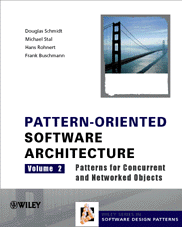Pattern-Oriented Software Architecture: Patterns for Concurrent and Networked Objects

|
Published by Wiley & Sons in
2000, ISBN 0-471-60695-2, order from amazon.com (US),
amazon.co.uk (UK),
amazon.de (Germany), German translation,
amazon.co.jp (Japan),
www.amazon.fr (France), Chinese translation, or Fatbrain.
This book is the second volume in the highly acclaimed
Pattern-Oriented Software Architecture (POSA) series, POSA1
was published in 1996 and hence this book is referred to as
POSA2. View
this page in Romanian courtesy of azoft.
POSA2 is written by
Douglas C. Schmidt
Michael Stal
Hans Rohnert and
Frank Buschmann
|
Designing application and middleware software to run in concurrent and
networked environments is a significant challenge facing software
developers. This document presents an overview of the contents in the
book Pattern-Oriented Software Architecture: Patterns for
Concurrent and Networked Objects (POSA2) that address this
challenge. The patterns in POSA2 form the basis of a pattern language
that addresses issues associated with concurrency and networking. The
book presents 17 interrelated patterns: Wrapper Facade,
Acceptor-Connector, Extension Interface,
Interceptor, Component Configurator,
Reactor, Proactor, Asynchronous Completion
Token, Scoped Locking, Strategized Locking,
Thread-Safe Interface, Double-Checked Locking
Optimization, Active Object, Monitor
Object, Leader/Followers,
Half-Sync/Half-Async, and Thread-Specific Storage. This
material represents a range of patterns from idioms to architecture
designs. The patterns cover core elements of building concurrent and
networked systems: service access and configuration,
event handling, synchronization, and
concurrency. All patterns present extensive examples and the
pattern known uses are presented in various programming languages,
including C++, C, and Java.
The book can be used to tackle specific software development problems
or read from cover to cover to provide a fundamental understanding of
the best practices for constructing concurrent and networked
applications and middleware.
Table of Contents
Please send us email if
you have any comments or suggestions for improving these documents.
Back to POSA patterns home page.

